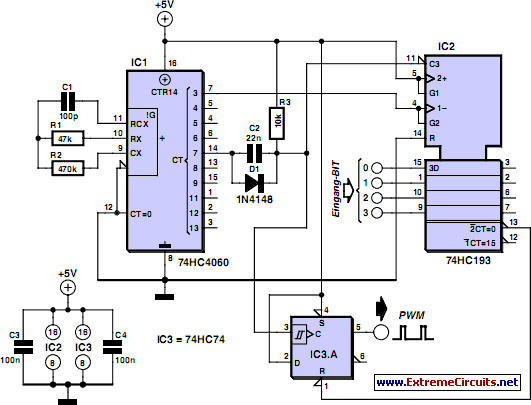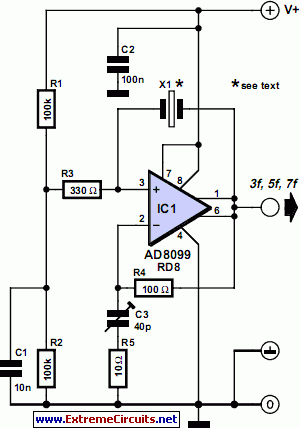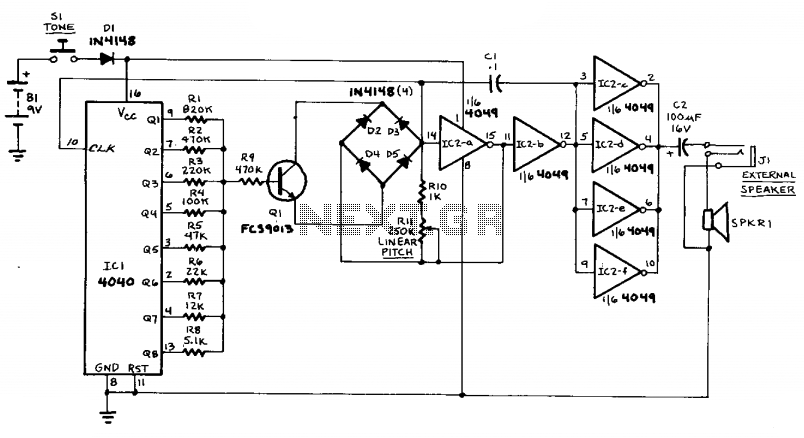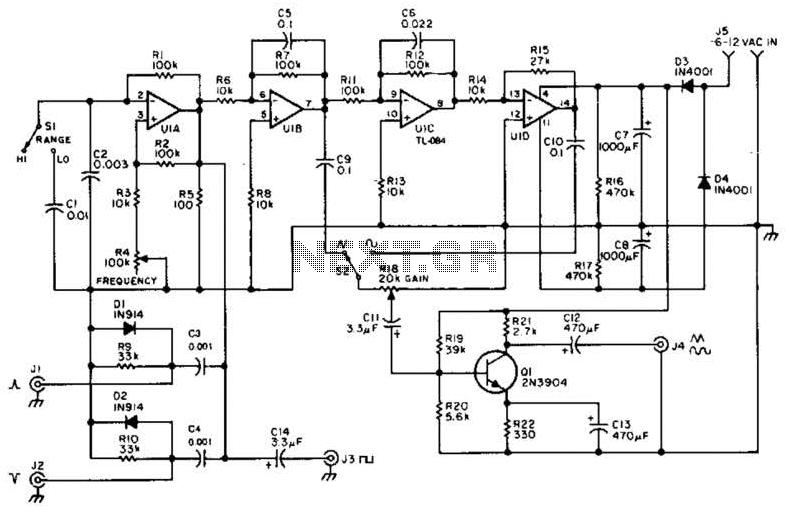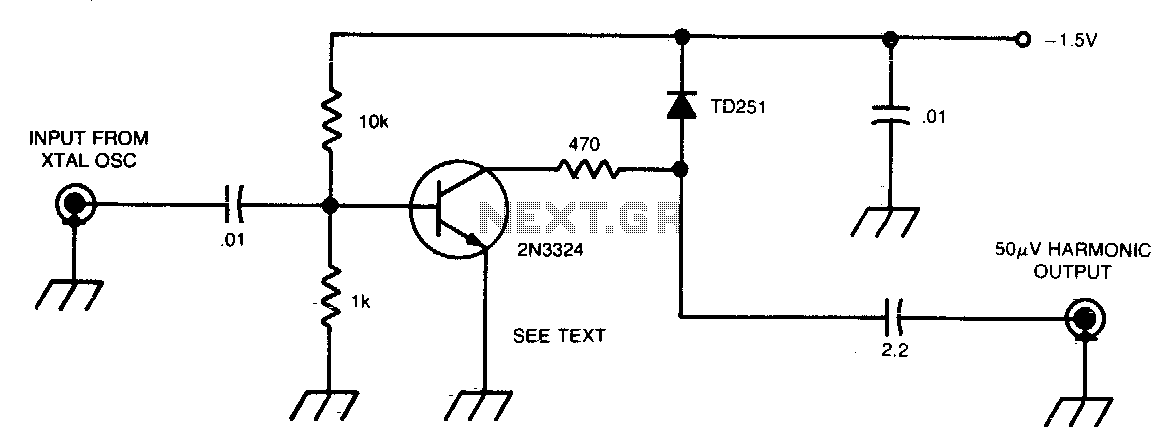
Pattern generator
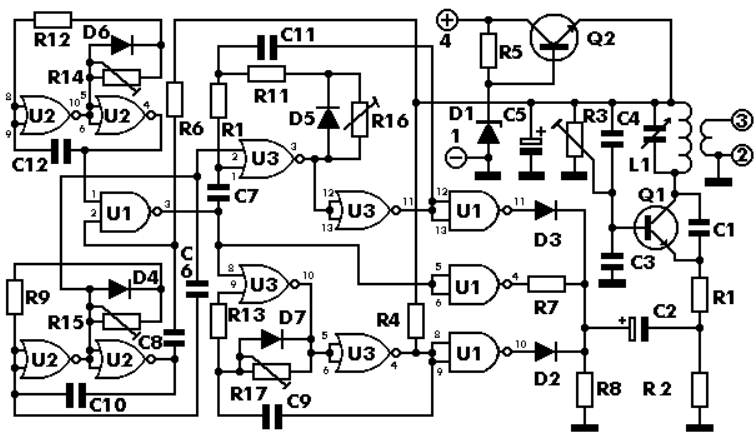
Technical Specifications - Characteristics
Working voltage: 9 VDC
Current drawn: 2 mA
Operating Frequency: 170 - 250 MHz (VHF)
Horizontal scan frequency: 16525 Hz
Vertical scan frequency: 50 Hz
Output impedance: 75 ohm
How it Works
The circuit can be divided into five distinct stages: four astable multivibrators and an output stage built around a VHF oscillator. The first astable multivibrator consists of two NOR gates in U2, along with components R9, R15, D4, C8, and C10. These two NOR gates function as inverters, forming an astable multivibrator that oscillates at a frequency of 16525 Hz, corresponding to the horizontal scan frequency of the television. This frequency can be fine-tuned using R15. Capacitor C10 provides the necessary feedback to sustain the oscillations. The signal from the output of this oscillator is transmitted through C8 and R6 to the output stage, where it modulates the signal.
The second multivibrator, constructed from the remaining two NOR gates in U2, along with R12, R14, D6, and C12, generates the pulses required for the vertical scanning frequency of 50 Hz. This frequency is directed to the input of one of the AND gates in U1 (pin 1). Another multivibrator, formed by two NOR gates in U3 along with components R13, R17, C9, and D7, creates pauses between pulses. These pauses are then fed to the AND gates in U1 (pins 8, 9, and 10), which are configured as inverters. This modulation results in the appearance of vertical stripes (bars) on the TV screen.
The final multivibrator, consisting of the last two NOR gates in U3 along with components R1, R11, R16, C7, and D5, produces the pulses that manifest as horizontal lines on the screen.
This circuit design effectively allows for the generation of a visual pattern that can be utilized for aligning the timing circuits of television receivers, ensuring optimal performance and synchronization. The careful arrangement of multivibrators and oscillators facilitates the precise generation of the necessary frequencies for both horizontal and vertical scanning, making it an essential tool in television servicing and repair.A pattern generator is a very useful instrument for the correct alignment of the timing circuits of a television set. The circuit we propose you to build, is a «bar generator» that will produce horizontal and vertical stripes (bars) on the TV screen, that will help you align the vertical and horizontal scanning synchronisation circuits of the receiver.
Technical Specifications - Characteristics
Working voltage: ................... 9 VDC
Current drawn: ...................... 2 mA
Operating Frequency: ........... 170 - 250 MHz (VHF)
Horizontal scan frequency: ... 16525 Hz
Vertical scan frequency: ....... 50 Hz
Output impedance: ............... 75 ohm
How it Works
The circuit can be divided in five different stages. Four astable multivibrators and the
output stage which is built around the VHF oscillator.
The first astable consists of two NOR gates in U2 and the components R9, R15, D4, C8,
and C10. The two NOR gates are used as inverters and together they form an astable
multivibrator which oscillates at a frequency of 16525 Hz, which is the horizontal scan
frequency of the TV, and can be fine-tuned by means of R15.
The capacitor C10 is there
to provide the necessary feedback to maintain the oscillations. The signal from the output
of the oscillator is taken through C8 and R6 to the output stage and modulates it.
The other multivibrator built around the other two NOR gates in U2, together with R12,
R14, D6 and C12 produces the necessary pulses for the vertical scanning frequency which
is 50 Hz. This frequency is fed to the input of one of the AND gates in U1 (pin 1).
The multivibrator built around two of the NOR gates in U3 and the components R13, R17,
C9 and D7 produces the pauses between pulses, which after being fed to the AND gates
in U1 (pins 8, 9 and 10) which are connected as inverters are then also used to modulate
the oscillator and appear on the TV screen as vertical stripes (bars).
Finally the last multivibrator which consists of the remaining two NOR gates in U3 together
with the components R1, R11, R16, C7 and D5 produces the pulses which appear on the
screen as horizontal lines.
🔗 External reference
